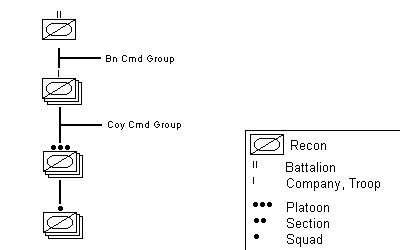

In 2301, IMS announced a major revision in the Table of Organization and Equipment (TO&E) for all of its ground military forces. This change was necessary due to changes in military doctrine and the renewed Kafer war offensive up the French Arm.
Under the new TO&E, the largest reconnaissance unit remains a battalion in size, but the sub-unit composition has been changed slightly, primarily at the squad binom level.
Battalions are classified by the standard two digit numerical designation with an R suffix.
xxxR ReconBn (system)
Where xxx is a numerical designation for the regiment, and indicates the chronological order of formation of the battalions,commencing from 10 and system indicates the star system in which the battalion was mustered.
For example, the 11R ReconBn (Sol) was the first reconnaisance battalion to enter service with IMS, and was formed in the Sol system.

The fundamental unit of any IMS personnel ground force is the binom. The binom is the standard unit of the French ground forces; from which the concept has been borrowed. A binom is comprised of two men, one of which mans the key weapon for which the binom is named, and the other who is tasked with the defense of the key weapon operator. The non-key weapon operator is generally armed as a rifleman, although he usually carries additional ammunition for the key weapon operator and functions as his assistant. In a typical squad, this results in a minimum of four riflemen, with three to four key weapon operators. This has proved to be the most flexible composition while providing good overall offensive and defensive capabilities at the squad level. As well, eight man squads allows the squad to split into two fire teams of four men each, similar to the basic unit of the USMC, with only the personnel in the squad. All NCOs and officers are cross-trained as surveillance specialists. All members are cross-trained in all other functions.
IMS reconnaissance units follow a TO&E up to battalion strength, but they generally operate independently, usually at the squad or platoon level. ACRs, HCRs, and HSRs each have one reconnaissance company, with a full battalion serving in a HCB.When reconnaissance companies are attached to composite units such as HCRs or ACRs, the command squad works in conjunction with the regiment staff, coordinating their respective units.
When reconnaissance squads use vehicles which have positions in excess of the number of men in the squad, vehicle crew positions are filled from available units (usually from mechanized or transport units). Squads use mainly ACVI-3 'Bessieres' hover APCs, but also may use Bridgeport Swift Warbirds, Rangestar 8's, Snow Gliders, Snow Demons, Metzer Aerosports, and Kangaroo IV APCs.Each Bessieres comes with a basic reconnaissance package weighing 175 kg and costing Lv8600. Additional equipment is issued for missions by need and availability. Personnel also carry extra reconnaissance equipment, but this various from unit to unit.
Basic Recon Package: Medkit, Medkit re-supply packages (4), shotgun mike (mounted), Sensortect (multi-sensor version), compact rations (30 man-days), Biomonitor, Radiation sensor, flares (12), pressure tent, cold climate clothing (8), climbing kit, vehicle communicator with scrambler (mounted), IR/UV lights (mounted), Battle radar, radio detectors (2), remote piloted drone, 4000 kg capacity power winch (mounted), vehicle maintenance tools, excavating tools, multi-purpose rechargeable fire extinguishers (2).
Reconnaissance units are often used as regular infantry in emergencies or if they are the only unit on a particular mission. In such cases, air defense and anti-vehicle missile launchers are carried in the squad vehicles for extra fire power.
As of 2301, IMS has six reconnaissance battalions at full operational strength.
These web pages developed and maintained by Terry A. Kuchta